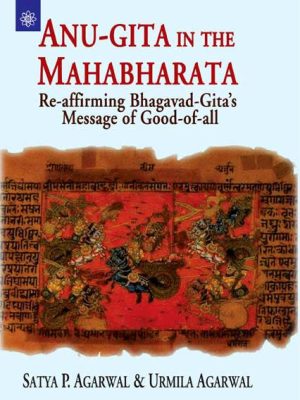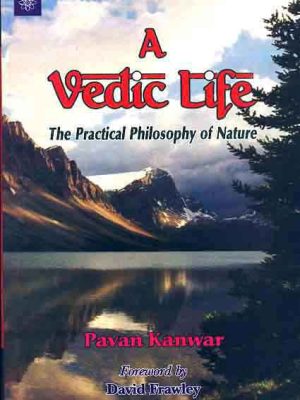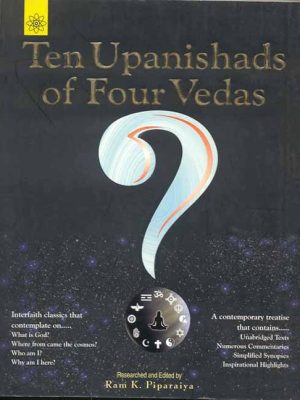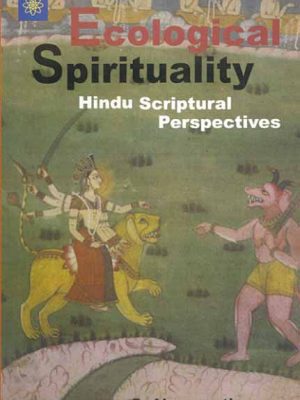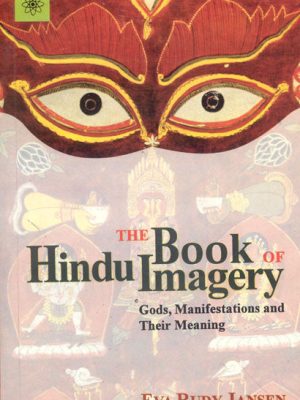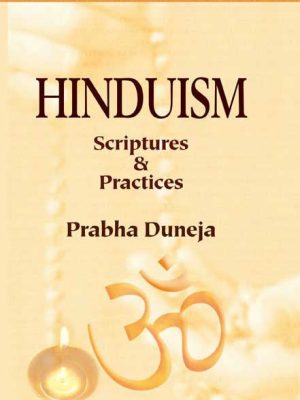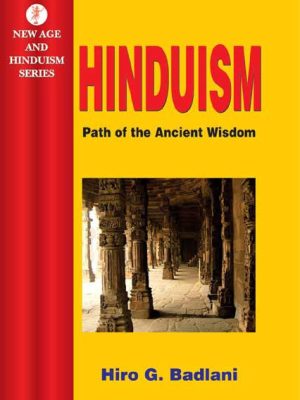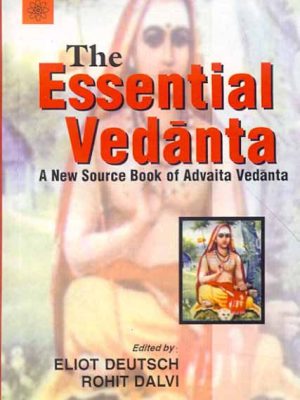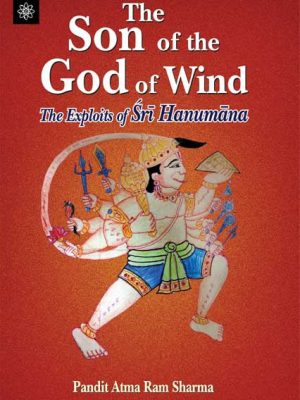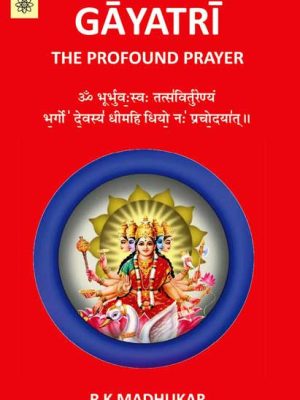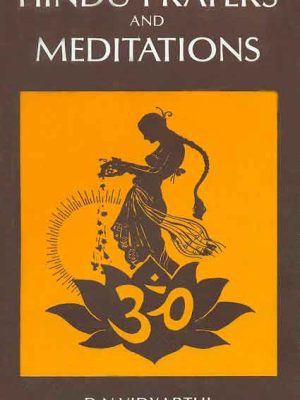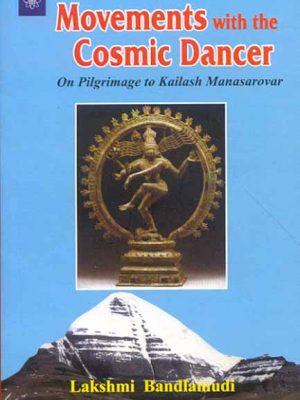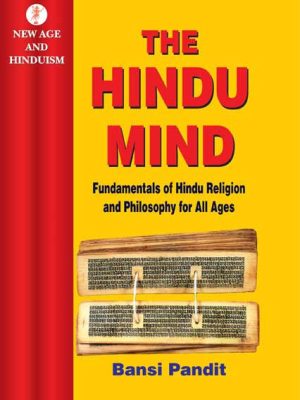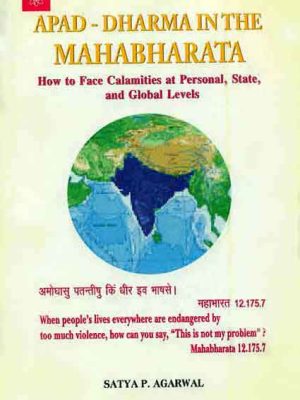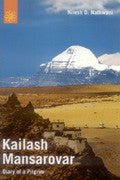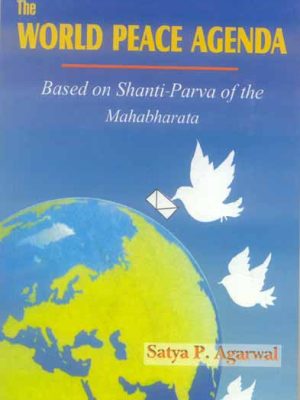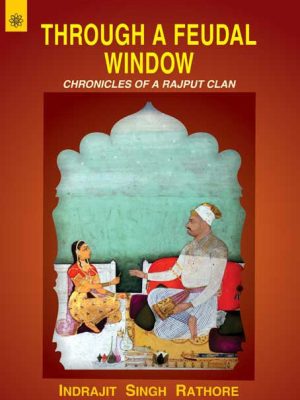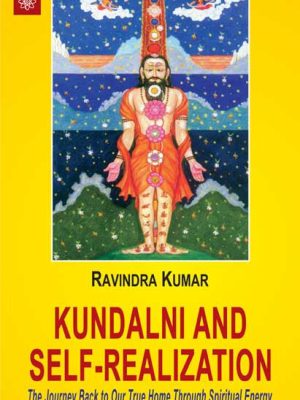New Age Books
-
Anu-Gita in the Mahabharata: Re-affirming Bhagavad-Gita’s Message of Good-of-all
Anu-Gita in the Mahabharata: Re-affirming Bhagavad-Gita’s Message of Good-of-all
The purpose of writing this book is to make available to English-knowing readers, an easyto-read version of Anu-Gita. Although Anu-Gita is an important part of the Maha-bharata, it has so far not been presented in a simple form to common people, with the result that most people do not even
know that such a book exists. The prefix ‘Anu’ denotes ‘after’, so Anu-Gita literally means ‘Gita occuring after’. In the Mahabharata, Bhagavat-Gita occurs in Parva No. 14. (In all, there are 18 Parvas in the Mahabharata).
It is well known that the Gita was taught by Lord Krishna to Arjuna on the battle field of
Kuruksetra. So it was a time of crisis at the time of Anu-Gita. In fact, the Mahabharata war was over and peace was established in the Kingdom, under the rule of Yudhisthira (whom every one including Arjuna supported).
But the format of Anu-Gita is different from that of the Gita. In the Gita, there was dialogue between Krishna and Arjuna. On the other hand, in Anu-Gita, Krishna makes use of three ancient
dialogues. Because of this, Anu-Gita has a lot of repetitions, which have made it longer than the
Gita. For example, Anu-Gita has thirty-six chapters (compared to eighteen chapters in the Gita), and 1040 shlokas (compared to 700 shlokas in the Gita). In order to present Anu-Gita in an easy-to-read version, the authors have omitted the repetitions, and have selected 400 shlokas. But they have retained all the main teachings of Anu-Gita.
Most people (even in India) have not heard the name of Anu-Gita. This is so because, although Anu-Gita is an important part of the Mahabharata, no scholarly study of it, in a simple language, has so far been published. This gap will be filled by this pioneering book, which explains under what circumstances was the Gita taught by Lord Krishna to Arjuna, for the second time. This book is divided into two parts. Part I presents the Sanskrit-shlokas of Anu-Gita, along with their translation in simple English. Part II explains the main points of similarity, as well as dissimilarity, between Gita and Anu-Gita.
Author
Satya P. Agarwal
₹250.00 -
A Vedic Life: The Practical Philosophy of Nature
A Vedic Life: The Practical Philosophy of Nature
In Sanskrit, the word veda refers to knowledge, and the ancient tradition known as the Vedic tradition is linked with India and focuses primarily on knowledge. It is not about any one kind of information, but rather about knowledge in general as a tool for comprehending and experiencing reality. As a result, it is a tradition that does not restrict itself to one one system. Instead, it takes a perspective that is open and inclusive, and it believes that a reasonable approach is very necessary. However, it does not restrict itself to logic alone; rather, it also examines an approach that is focused on inner perception, since this is a vital aspect of both our knowledge and our experience of reality. The book titled “A Vedic Life” is a presentation that outlines some of the most significant aspects of the Vedic method of approaching information. It does this not for any specific religious or sectarian motive, but rather for the sake of knowledge, as indicated above, and as a result, it is anticipated that it will be able to contribute something to a range of opinions. Although the Vedas (books of wisdom) are intimately connected with the Vedic approach to knowledge because they exemplify its open and inclusive approach to information, the Vedic approach to knowledge is not limited to any one individual or book, as was previously noted. This aspect of the Vedic writings is expressed in a phrase from the Rig Veda, one of the core Vedic books, which states that “reality is one, but the knowledgeable call it by numerous names.”
The Vedic tradition is not the only one that has an open attitude toward knowledge; nonetheless, it is perhaps the most in-depth and oldest system of its kind. It is also the best maintained, despite the fact that a significant amount of its knowledge has been lost in modern times. Despite the fact that many of its pioneering philosophers had a completely different perspective, the system of contemporary science obviously clearly strives to the same ends; nevertheless, it does not truly recognise any other kind of thought than that which is founded on reason and sensory evidence. This book will examine the benefits and drawbacks of the methodology that is being used by contemporary science, particularly in light of the Vedic methodology for doing scientific research.
Because Sanskrit being the primary language used throughout the Vedic period, the book makes extensive use of Sanskrit words and phrases throughout its content. Once again, this is not due to any kind of ceremonial purpose; rather, it is due to the fact that the Sanskrit language used in the Vedas has a very well developed vocabulary in relation to psychology and philosophy. In addition, an effort will be made to show that Sanskrit is a natural language for the purpose of acquiring information, and this effort will be documented.
₹225.00 -
Ten Upanishads Of Four Vedas
Ten Upanishads Of Four Vedas
Ten Upanishads Of Four Vedas,Ram K.Piparaiya: A modern treatise that includes whole texts, extensive commentaries, condensed summaries, and pivotal points of inspiration. This book is a valuable compilation of the original Upanishadic writings as well as commentaries on those works. Classic works from a variety of faiths that provoke thought on. Who is God, exactly? Where did everything in the universe come from? Just who am I? Why am I in this place?
The Upanishads provide a chronicle of the human mind’s early voyages into the realm of the unknown via contemplation.
At the very least, a few centuries separated many of the nameless searchers from famous teachers and prophets such as Lao-Tzu, Confucius, Socrates, Zoroaster, Buddha, Mahavira, Abraham, and Jesus. Among the anonymous seekers were those who came before them.
In the Upanishads, the link between man, God, and the universe is illustrated via a variety of intriguing tales and metaphors.
Aphorisms are short sayings that pack a lot of wisdom into a little amount of space.
The sheer sight of Upanishads texts on a bookshelf is enough to evoke contemplation of wisdom after just a few moments of reading them.
About the Author(s)
Shri Ram Piparaiya
₹2,000.00Ten Upanishads Of Four Vedas
₹2,000.00 -
Ecological Spirituality: Hindu Scriptural Perspectives
Ecological Spirituality: Hindu Scriptural Perspectives
Every major step man takes wreaks its own damage on the environment. Aware of this, man is yet unwilling to forgo the immediate material benefits his actions give. for all his professions of concern aabout the environment, in reality his concern reduces to nothing more than cosmetic changes in the exterior which are of no value. This celender monograph is critique on this pervasive culture of ambivalence. The author resorts to the first principles, Sanatana Dharmawhich literally means eternal order. Not environmental engineering but ecological spirituality is the answer. In Fact this is the only religion the world needs.
About the Author(s)
G. Naganathan
₹200.00 -
The Book of Hindu Imagery: Gods and Their Symbols
The Book of Hindu Imagery: Gods and Their Symbols
Hinduism is more than a religion; it is a way of ife that has developed over approximately 5 milennia. Its rich and multicultured history, which has no equivalent among the great religions of the world, has made the structure of its mythical and philosophical principles into a highly
differentiated maze, of which total knowledge is a practical impossibility.
This volume cannot offer a complete survey of the meaning of Hinduism, but Eva Rudy Jansen does provide an extensive compilation of important deities and their divine manifestations, so that modern students can understand the significance of the Hindu pantheon.
To facilitate easy recognition, a survey of ritual gestures, postures, attires and attributes as well as an index are included. Over 100 illustrations and several photographs make this book an important
reference, both to the student of Hindu art and the interested amateur.
About the Author(s)
EVA RUDY JANSEN
₹295.00 -
Hinduism: Scriptures and Practices
Hinduism: Scriptures and Practices
In this book the author has sincerely endeavored to give an introduction to the study of the
Hindu religion both in its theoretical as well as practical aspects. Beginning from an introduction
to the Holy Vedas, Upanishads, and Manusmriti, through the great epics – the Ramayana and
Geeta – the Hindu gods and goddesses, festivals and the customs of our rich cultural heritage, she
has tried to cover a wide spectrum of subjects to the interest of the younger generation, from a new and contemporary way of life. The short and succinct summary of the Vedic rites and rituals,
Patanjali Ashtanga Yoga and meditation makes the
book more faithful to its subject.
The Vedic religious practices have been created and supported by some spiritual concepts and loyalty to the perseverance of these traditions has been emphasized over centuries. The entire
social structure in Hindu society is centered in religious beliefs, followed by Hindu families through the ages. The contents of all the essays are intended to add depth to the clear understanding of time-honored spiritual traditions that form the significant features of Hindu culture. Each topic offers valuable insights into the systematic exploration of the subject.
₹400.00 -
Hinduism: Path of the Ancient Wisdom
Hinduism: Path of the Ancient Wisdom
Hinduism is the oldest surviving religion in the world. It has evolved from prehistoric times through various phases of ongoing development and includes religious and spiritual literature which is vast and diverse. This book provides a well groomed summary of all aspects of Hinduism in a simple and straightforward language. It includes 63 chapters spread over 367 pages. Chapters 1 through 18 discuss the origin of Hinduism and its scriptures, Hindu spirituality, Hindu code of conduct, soul consciousness, the divine path of virtue, and Hindu Trinity. Chapters 19 through 42 include topics such as teachings of Ramayana, Mahabharata, Bhagavad Gita, ancient philosophy of Yoga, Buddhism, Jainism, Sikhism, teachings of Bhagavatam and spiritual teachings of some of the popular Hindu saints such as Vivekananda, Paramahansa Yogananda, Swami Chinmayananda and many other spiritual masters. Chapters 43 through 56 provide discussions on Hinduism and science, meditation, satsanga (holy company), Ayurveda, vegetarianism, Hindu wedding, Hindu symbols and icons, Hindu customs, festivals, interfaith issues and Hinduism and fine arts. The remaining chapters 57 through 63 include discussions on evolution of Hindu temples, a pilgrimage through India, Hindu temples in USA and rest of the world, and Hindu prayers.
Message from Baba Hari Dass, Mount Madonna, Santa Cruz, California. ‘Hinduism: Path of the Ancient Wisdom’ gives the ancient history of Hinduism. The book is like a map of Hinduism, which shows from where one should start his or her spiritual journey, and where the journey ends. This is also a guidebook to those who don’t know what Hinduism is, especially for those Hindus who are settled in foreign countries and have no knowledge of their own religion.
Writing this book has been like playing the second inning of my life. The first inning was my medical career of over forty years in Mumbai, India. After retiring, my wife and I set up base in the United States. It was then that a friend gave me a book titled The Essentials of Hinduism by the learned Swami Bhaskarananda of Seattle, Washington. The book fascinated me so much that I read it many times and later developed a close relationship with the author. I resumed a childhood habit of reading extensively, but this time, my reading was not for just any book; rather, it was exclusively for works on Hinduism. There was an urge to explore and search the deeper meaning embedded in the Hindu faith.
₹450.00 -
The Essential Vedanta: A New Source book of Advaita Vedanta
The Essential Vedanta: A New Source book of Advaita Vedanta
The Essential Vedanta is a comprehensive introduction to the tradition of Advaita Vedanta based upon primary sources and makes possible a study of it in its classical form. Translations from all major sanskrit writings are included as well as selections from all of the most important representatives of this central philosophy of India.
About the Author(s)
Rohit Dalvi
₹450.00 -
The Son of the God of Wind: The Exploits of Sri Hanumana
The Son of the God of Wind: The Exploits of Sri Hanumana
The majority of the population in India is devoutly religious. In India, a significant portion of the populace reveres Hanumana as a deity. Sri Hanumana ji temples can be found in every hamlet, town, and city in India. A lot of people are inspired, energised, and awakened by the spirit of Sri Hanumana Ji. It encourages them to work hard, be religious, and help others. As long as Sri Hanumana ji is around, he maintains them on the right road.
Because of his devotion to Sri Rama, Hanumana ji has lost his sense of self-identity and no longer exists independently of the Lord. He embodies all of the attributes that Sri Rama possesses. Hanumana, an avatar of Visnu, represents the pinnacle of Hindu devotion to Lord Rama. That is why he is so highly regarded.
The present work is the result of translation of selected stories about Sri Hanumana by late Pandit Atma Ram Sharma. Despite the fact that the translation only includes a few stories, the stories are all connected and make for an interesting read.
Nonresident Indians, who are always looking for a method to feel more deeply connected to their religious and cultural traditions, may find this book particularly interesting.
Author
PANDIT ATMA RAM SHARMA
₹400.00 -
Gayatri: The profound prayer
Gayatri: The profound prayer
Gayatri is a profound prayer. It is an authentic prayer that elevates, exhilarates and enlightens. According to Hindu scriptures, a prayer in its real sense is not just chanting of a few verses. It is a comprehensive exercise that involves jnana (knowledge), dhyana (meditation) and anubhava (experience). Gayatri Mahamantra is a true prayer that not only reaches out but also reaches in.
Gayatri is chanted as a Mahamantra, worshipped as the Mother Goddess and expressed as a Meter. It is not a prayer for worldly and material benefits. Gayatri is a prayer for the highest enlightenment. It is a prayer that leads to a sublime experience, a prayer that opens up our mind and vision, body and intellect to a world beyond the worldly attachments. It is a prayer that leads to the Ultimate Truth and Supreme Bliss that every enlightened human being seeks.
Gayatri, like the Vedas, is meant for the entire mankind, irrespective of gender, caste, creed, religion or nationality. It is a profound prayer that can touch and transform every human being.
This book is a good read for everyone who believes in the efficacy of prayer and meditation. It is also a good read for everyone who wishes to gain an insight into the breadth and depth of ancient Indian wisdom – the Sanathana Dharma. This informative book is meant for every generation, both young and old.
Review(s)
Gayatri-The Profound Prayer is the authorÍs first spiritual book. Writing it has been a divine spiritual experience for him. -SWAMI BALAKRISHNANANDA SARASWATHI Founder of Gayatri Tapobhoomi, Tadas, Hubli, Karnataka
Author
Madhukar
₹495.00Gayatri: The profound prayer
₹495.00 -
Hindu Prayers and Meditations
Hindu Prayers and Meditations
Hindus must pray daily morning at sunrise and evening at sunset one must have divine communication with God, and ask Him for Light and Guidance in life. Hindu scriptures abound in prayers. They are of different types and of complex nature, and form part of various rituals and ceremonies. In our daily life, however, we need not be bothered with these complexities. A few simple prayers, will serve our needs beautifully. The only thing we have to constantly keep in mind is the purity of our hearts and sincerity of purpose. We cannot offer prayers precariously and half-heartedly.
Author
D.N. Vidyarthi
₹225.00Hindu Prayers and Meditations
₹225.00 -
Movements with the Cosmic Dancer: On Pilgrimage to Kailash Manasarovar
Movements with the Cosmic Dancer: On Pilgrimage to Kailash Manasarovar
Lakshmi Bandlamudi’s description of her journey to Kailash and Manasarover, representing as they do Purusha and Prakriti, the masculine and the feminine nature of existence, is deeply moving because she connects it to her own inner spiritual quest. Replete with mythical stories regarding Shiva and Parvati, and written with a special emphasis on the feminine, this book is a moving testament of a living faith which has persisted for thousands of years.
Lakshmi Bandlamudi’s script is a sublimely cosmic dance in itself hinting at a difficult life and a less than easy journey; she nonetheless describes her journey to Kailash the home of Shiva, as a transcendental pilgrimage of the soul. The story Tibetan territory she must traverse becomes almost irrelevant in her soul’s searching for answers to questions, which are both personal and universal.
Author
Lakshmi Bandlamudi
₹295.00 -
The Hindu Mind: Fundamentals of Hindu Religion and Philosophy for All Ages
The Hindu Mind: Fundamentals of Hindu Religion and Philosophy for All Ages
Hinduism is the oldest surviving religion on the world. The religions and philosophical literature of Hinduism is vast, diverse and covers thousands of years of accumulated spiritual experiences of Hindu Saints and Seers. This book presents the fundamentals of Hindu religions and philosophical thought in a logical and straightforward manner. The purpose being, to create a story book for further study of Hinduism.
₹500.00 -
Apad-Dharma in the Mahabharata: How to Face Calamities at Personal, State, and Global Levels
Apad-Dharma in the Mahabharata: How to Face Calamities at Personal, State, and Global Levels
The literal meaning of the Sanskrit word “Apaddharma” is “dharma appropriate at the time of calamity”. The Mahabharata’s use of this expression implies that, in the opinion of the author of this epic, the traditional varnashramadharma would not prove to be strong enough to protect the society, if and when there is a calamity. Therefore, Vedic scholars ought to have welcomed the messages of Apad-dharma when the society was actually attacked by external forces during the premodern period.
The historical background of the present study poses an important, academic question: “How could the Indian society have protected itself against external attacks during the pre-modern period?” Research-based answers to such Indiarelated questions occupy the initial part of this book to which a global dimension has been added by digging deep into Mahabharata’s innumerable stories. Results of innovative investiga-tions into the general question “How to face calamities at personal, state and global levels”, are presented here in terms of a modern, scientific framework, and expressed in a non-denominational
terminology, relevant to the problems of the 21st century. Readers from all parts of the world can get a strong message of social responsibility from this book, and accordingly make their contribution to the cause of world peace.
₹225.00 -
Kailash Mansarovar: Diary of a Pilgrim
Kailash Mansarovar: Diary of a Pilgrim
This profusely illustrated travelogue is a tale about fancies and fears, adventures and aspirations, expectations and disillusions, escapes and retreats experienced by a team of adventurous pilgrims. This is a story of an unforgettable odyssey to the holy Mount Kailash and the sacred Mansarovar describing mysteries connected with the land capturing the intangible air of faith and pilgrimage. This travelogue takes us on a journey to the wild, seldom travelled northern route visiting the remote cities, towns and monsteries of mysterious Tibet. It is a gripping story of pilgrims who aspire to see Gods living in the wilderness of the remote holy land. This is an engrossing, touching and remarkable account of a picturesque travel with nice imagery describing majestic mountains, turquoise lakes and virgin rivers of Tibet. Written in a brilliant style, it is a dramatic record that succeeds in imparting onto the readers some of the intensely experienced emotions that will remain long in memory. This book has been included in the Tibetan Travel Classics, Pilgrims Publishing, Varanasi, India and Pilgrims Book House, Kathmandu, Nepal.
₹225.00 -
The World Peace Agenda: Based on Shanti-Parva of the Mahabharata
The World Peace Agenda: Based on Shanti-Parva of the Mahabharata
This book presents Shanti-Parva’s peace-messages for consideration by everyone else. With the hope that plenty of purposeful discussion (with an open mind) will be held, to arrive at new proposals which can help bring world peace within the reach of humankind in the twenty-first century. Readers will discover that the peace-promoting messages of Shanti-Parva (when suitably interpreted) have universal appeal even today. These messages envisage the launching of a new peace-initiative, based on the explicit declaration of the Mahabharata verse 12.94.1 that says “wars cannot provide a satisfactory solution to any dispute”, and incorporate several novel features which are summarized in the last chapter of this book.
₹225.00 -
Kangra Valley: My Spiritual Journey…
The Kangra Valley in the state of Himachal Pradesh, India, is one of the most fascinating travel destinations in the region, both for its spiritual sites as well as the spellbinding landscape. This amazing landscape is home to many religions, most notably Tibetan Buddhism and Hinduism, Christianity and Sikhism. Much like other regions in the Himalayas, this convergence of spirituality has given rise to a special culture, which can be seen in the day-to-day activities of the communities living here. Its given a sense of harmony and strength in the region for thousands of years and it resonates all across Kangra Valley.
₹2,200.00Kangra Valley: My Spiritual Journey…
₹2,200.00 -
Through a Feudal Window: Chronicles of a Rajput Clan
This is the story of every Rajput feudal family in Rajasthan through Indian History.
This is a tale of extraordinary survival of a clan over a millennium. The chronicles of the
Mertia Jagmalots trace their origins to their progenitor Rao Duda of Merta and through him to
the Rathore clan of Rajputs. The martial Rajputs, according to many historians, descended from the Scythians who ruled large tracts of northern India in the early centuries of the first millennium A.D.
₹800.00
